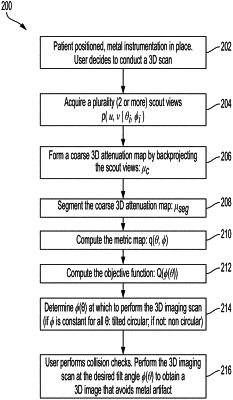| CPC G06T 7/0012 (2013.01) [A61B 6/12 (2013.01); A61B 6/4441 (2013.01); A61B 6/4447 (2013.01); A61B 6/5205 (2013.01); A61B 6/5258 (2013.01); G06T 7/70 (2017.01); G06T 11/005 (2013.01); G06T 11/006 (2013.01); G06T 2207/10081 (2013.01); G06T 2207/20084 (2013.01); G06T 2207/30004 (2013.01)] | 20 Claims |

|
1. A method for metal artifact avoidance in 3D x-ray imaging, the method comprising:
determining a 3D location of metal in an object or volume of interest to be scanned;
estimating a source-detector orbit that will reduce severity of metal artifacts, wherein the source-detector orbit is a non-circular orbit that is defined by a tilt angle and a rotation angle of a gantry arm are varied during a scanning operation, wherein the estimating the source-detector orbit further comprises computing an objective function that is based on the 3D location of the metal that was determined, wherein the objective function describes a spectral shift that is associated with metal artifacts in 3D image reconstruction;
moving an imaging system to locations consistent with the source-detector orbit that was estimated or to locations close to the source-detector orbit that was estimated and within existing spatial constraints; and
scanning the object or the volume of interest according to the source-detector orbit.
|